When it comes to building a backyard that attracts birds and insects, Jim Durbin of Marion has really done so.
Durbin, who runs the websites Birds of Iowa and Insectsofiowa.org, noted that he has had 156 different species of birds and more than 300 different varieties of insects who have stopped at his home, was the speaker at Lester Buresh Family Community Wellness Center’s last adult speaker series session for 2023.
He noted that when he and his family moved to Marion, they had a traditional yard.
“Which was great when our kids were still in school and used it to play games,” Durbin said. “As they’ve grown up and moved on, however, that typical grass yard just became something you would maintain.”
He started slowly landscaping his back and front yards, and focused primarily on things that would attract birds and insects.
“The primary things you need to help attract birds to your yards is water, cover and feed,” Durbin said. “A lot of the problem for homeowners is finding the right covers to use.”
He said that has gotten hard when looking at some of the plants offered at garden centers.
“Some of the hybrids that are released these days don’t flower or provide nectar that insects here will utilize,” Durbin said. “Without that, you need other perennial plants or annuals that will attract insects and birds.”
The biggest piece of advice he tells anyone looking to build an ecosystem to attract birds and insects is to start small with things you want in your yard and grow from there.
His landscaping has grown to encompass both his front and back yard, and entails a lot of native to Iowa species of plants and trees.
He has had some setbacks over the years. He lost a sycamore tree in his front yard several years ago that provided a lot of shade to other plants there. This forced him to move some of the plants that preferred shade from that portion of the yard to other locations in his yard and to find plants that don’t mind direct sunlight.
Raccoons have torn apart some of the liners he has had in his front pond, as they try to get at some of the water and fish found there, making him rethink that portion of his landscaping.
“The key for any landscape work you are doing is to be able to enjoy the work you are completing in your yard,” Durbin said.
He said that Iowa soil allows many plants to thrive as long as it wasn’t just clay to start with, and he has used minimal chemicals or additives.
He also borrowed heavily from his daughter’s home in the Jones County countryside for some of the native plants, such as milkweed, that attract certain insects.
A questioner asked how much work he has reducing weeds in his yard. Durbin said that for the first week or two in early spring, he will cut back anything he doesn’t think belongs, but as plants get growing themselves, they are able to stop many of those weeds from propagating.
“What you’re really trying to create in your yards is something similar to the plants you see at the edge of the woods, or in clearings,” Durbin said. “Those trees that have berries, foliage that helps provide cover for birds to hop around in.”
He said it has been amazing to see how many insects he is able to attract, even though he lives in a city, just by providing plants they might enjoy.
This year’s drought, has made it interesting to see the birds and insects who still were at his home. He worries about how many of his plants will weather this winter, and what he’ll have to work at replacing in the spring.
But because of the work, he also sees birds and insects year round, part of that ecosystem that he has helped to create.
On top of the insects, he also offers seeds that different species of birds will eat in order to help attract more birds.
“Some smaller birds won’t eat the large sunflower seeds, they prefer the very fine chopped variant of sunflower seeds, where others do like those full seeds,” Durbin said.
Building birds and bee habitats – gardening focus with Jim Durbin
November 9, 2023
LBC Speaker
About the Contributor
Nathan Countryman, Editor
Nathan Countryman is the Editor of the Mount Vernon-Lisbon Sun.

